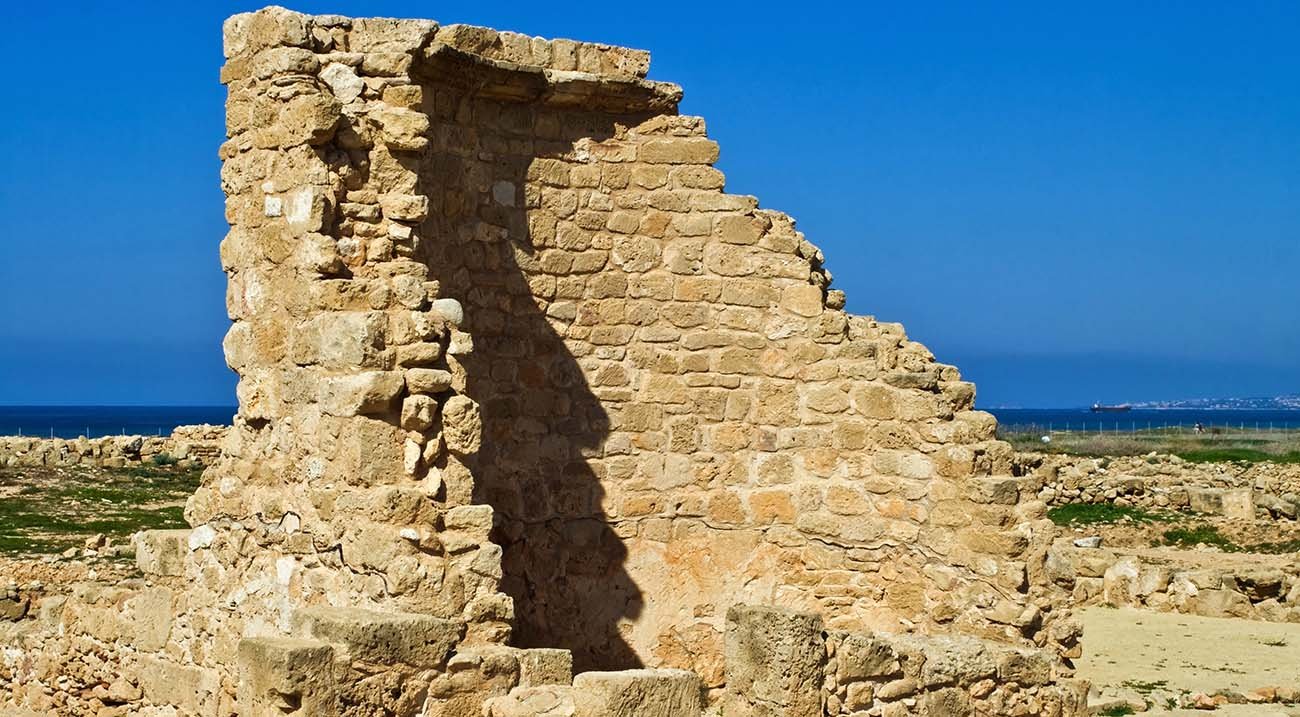
Nea Pafos is situated on a small promontory on the southwest coast of the island. The town was apparently founded at the end of the 4th century B.C. by Nicocles, the last king of Palaipafos. In early 3rd century B.C. when Cyprus became part of the Ptolemaic kingdom, which had its capital in Alexandria, Nea Pafos became the centre of Ptolemaic administration on the island, ultimately becoming its capital. When in 58 B.C. Cyprus was annexed by Rome, Nea Pafos continued to be the capital of Cyprus. After the disastrous earthquakes of the 4th century A.D. the capital was transferred to Salamis, which was then renamed Constantia. Even then however, Nea Pafos dominated the other cities of Cyprus. After the Arab raids of the middle of the 7th century, Nea Pafos went through a period of decline, which lasted a few centuries, and reduced in size. The town regained some of its importance during the Byzantine and the Medieval periods but from the Venetian period onwards the coastal settlement of Nea Pafos was abandoned and the population began to move further inland where the present town of Pafos (Ktima) developed. Learn about this development first hand from our 4VIP Tour guide.
Systematic excavations at Nea Pafos began in 1962, during which phase many of the ancient town’s administrative buildings as well as private houses and ecclesiastical buildings came to light. Nea Pafos has also been the centre of excavations and research by many foreign archaeological missions from Universities and Schools from all over Europe, America and Australia.
In 1980 Nea Pafos and Palaipafos were added to the World Heritage List of UNESCO.
Some of the more important monuments at the site are:
The House of Dionysos: This rich building belongs to the Greco-Roman type where the rooms are arranged around a central court, which functioned as the core of the house. The house was probably built at the end of the 2nd century A.D. and was destroyed and abandoned after the earthquakes of the 4th century A.D. The House of Dionysus occupies 2000 sq. m. of which 556 are covered with mosaic floors decorated with mythological, vintage and hunting scenes. At the House's entrance these is a pebble mosaic representing the mythical sea-monster Scylla that belonged to a Hellenistic building found below the later Roman one. 4VIP Tours can arrange an excursion for those keen on digs.
The House of Orpheus: It belongs to the type of the wealthy Greco-Roman Houses with a central court similar to the House of Dionysus. It dates to the late 2nd /early 3rd century A.D. The building’s main room, the reception hall, is decorated with a mosaic floor depicting Orpheus among the beasts. The next room’s mosaic floor bears two panels, one representing Hercules and the Lion of Nemea, and the other an Amazon with her horse.
The Villa of Theseus: The villa was built in the second half of the 2nd century A.D. over the ruins of earlier houses of the Hellenistic and early Roman periods and was in use until the 7th century A.D. The villa's large size and consisted of more than 100 rooms suggests that the building was the residence of the governor of Cyprus. Many of the rooms and three of the four porticos around the central court are covered with mosaic floors with geometric motifs. Three rooms in the south wing of the building are embellished with mosaic floors with human representations, all belonging to different phases. The oldest one is the mosaic representing Theseus and the Minotaur, dating to the very end of the 3rd or beginning of the 4th century A.D. with obvious later restorations, probably made after the earthquakes of the middle of the 4th century. At the end of the 4th century A.D. a new mosaic depicting Poseidon and Amphitrite was added to a room, which probably served as a bedroom. Finally, at the beginning of the 5th century, a mosaic floor was laid in the reception room, of which only a part is preserved today and depicts Achilles´ first bath. A fascinating prospect for archeologists.
The House of Aion: Only part of the house has been excavated so far. On the floor of an apsidal room, lies the most spectacular mosaic of Pafos dated from the middle of the 4th century A.D. The mosaic, which is of excellent quality, consists of five figural panels depicting the newborn Dionysos, Leda and the Swan, the beauty contest between Cassiopeia and the Nereids, Apollon and Marsyas, and finally the Triumph of Dionysos.
The Agora: The Agora, of which only the foundations are preserved today, has the form of a court surrounded by four porticos. The buildings occupying the west wing of the agora are the best preserved. They include an Odeon, which was restored by the Department of Antiquities and accommodates various cultural events today, and the Asklepieion. The whole complex dates to the 2nd century A.D.
The Theatre: Located in the northeastern part of the ancient city, on the slopes of the so-called “Fabrica” hill. The University of Sydney, Australia is currently conducting excavations at the site. The construction of the theatre dates to the founding of the city but it went through alterations and its original plan changed during the Roman period. It seems that the theatre continued to be in use until the 5th century A.D.
The Basilica of Chrysopolitissa: It is one of the largest basilicas built on the island in the second half of the 4th century A.D. Originally it had seven aisles, which were compressed into five during alterations dating to the 6th century. The rich geometric decoration of the mosaic floors of the basilica dates them to the 4th and 6th centuries A.D. In the central aisle three unique figural scenes representing Christian allegories are preserved. After the destruction of the basilica, a Byzantine church was built on the site in the 11th century. This was followed by a second church dated to around 1500 A.D., which still stands today and functions as Pafos' Anglican church. North of the basilica the ruins of a gothic church belonging to a Franciscan monastery are visible. The gothic church was built around 1300 A.D. and fell into ruin in 1600 A.D. Even then, it is well worth an excursion in Cyprus.
Within the framework of the Ministry of Communications and Works' campaign for accessibility to individuals with disabilities, a network of pedestrian bridges have been designed and incorporated in the archaeological site of the Basilica of Chrysopolitissa . Information panels have also been positioned at the beginning of these new routes.
The Castle of 'Saranda Kolones': The Byzantine castle known as 'Saranda Kolones' ('Forty Columns') due to the great number of granite columns preserved on the site, is located near the port, south of the agora. The castle was built in the 7th century A.D. to protect the port and the city of Nea Pafos from the Arab raids and it remained in use until 1223 when it was destroyed by an earthquake.
You could not imagine your visit to Cyprus without sightseeing Paphos Park.
Private car with driver for 3 hours
120 euro
Additional hour
25 euro
Cost based on 2-4 Person
Private minibus with driver for 3 hours
220 euro
Additional hour
35 euro
Cost based on 5-8 Person





